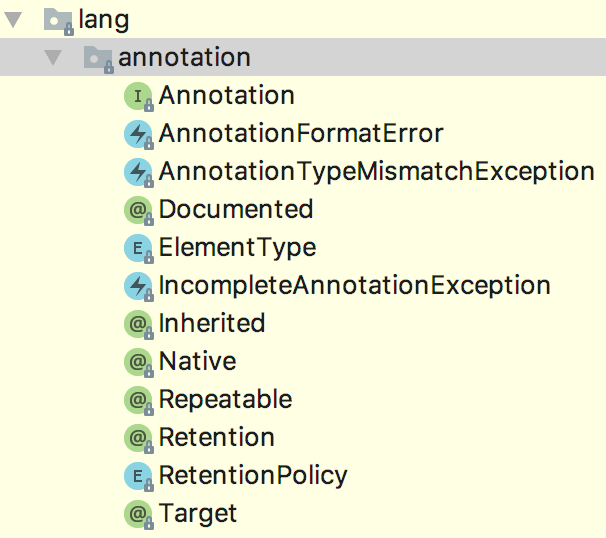Java 在 jdk 1.5 增加了注解,为我们的开发带来了更多的可能性。如 spring 中的注解,极大的简便了我们的开发,并提高了代码的可维护性。注解源码主要在 java.lang.annotation 包中,内部结构如下所示。

1 API
下面介绍相关 api,主要介绍一些常用的api,其他 api 可查看官方文档。
1.1 Interface
Annotation 是所有注解类型的公共接口,也就是我们任何一个注解都是隐式实现了这个接口。在开发过程中,我们没有继承这个接口,而是使用 @interface 声明一个注解。
public interface Annotation {
boolean equals(Object obj);// 比较
int hashCode();// hash 值
String toString();// 获取注解的字符串表示
Class<? extends Annotation> annotationType();// 获取注解的类型
}1.2 Enum
1.2.1 ElementType
ElementType 在 @Target 中使用,主要是描述一个注解的使用区域。
public enum ElementType {
TYPE, // 类,接口,枚举
FIELD, // 字段或枚举的常量
METHOD, // 方法
PARAMETER, // 方法参数
CONSTRUCTOR, // 构造函数
LOCAL_VARIABLE, // 局部变量
ANNOTATION_TYPE, // 注解类型
PACKAGE, // 包
TYPE_PARAMETER, // Type parameter declaration
TYPE_USE // Use of a type
}ElemenType 可以多个同时使用,在后面会为大家代码演示。
1.2.2 RetentionPolicy
RetentionPolicy 在 @Retention 中使用,主要是描述一个注解的保留阶段。
public enum RetentionPolicy {
SOURCE,// 注解只存在与源码中,编译器无法识别
CLASS,// 编译器可识别注解,运行时无法获取
RUNTIME// 注解在运行时可以通过反射机制获取
}多数情况,我们都是设置为RUNTIME。但是有的时候会有特殊需求,我们会设置其他级别,如 @Override 。
1.3 Annotation Type
1.3.1 Documented
Documented 表明该注解可通过工具生成javadoc文档。
1.3.2 Inherited
Documented 表明子类可以获取父类的注解。如父类中使用了该类型的注解,我们在子类通过java 反射机制时,也可获取该注解。
1.3.3 Native
Native 定义的注解可以在常量值使用。
1.3.4 Repeatable
Repeatable 表明注解是可以重复的。如我们想在一个注解中使用另一个注解则需要使用 Repeatable。
1.3.5 Retention
Retention 指明注解的保留阶段,如 @Retention(RetentionPolicy.SOURCE) 表示只存在于源代码中。
1.3.6 Target
Target 表明注解的使用区域。如 @Target({ElementType.FIELD, ElementType.METHOD}) 定义该注解只能用于字段和方法。
2 实战
我们定义一个简单的注解,其中包含所有可使用的区域。
@Target({ElementType.TYPE, ElementType.CONSTRUCTOR, ElementType.METHOD, ElementType.PARAMETER, ElementType.FIELD,
ElementType.ANNOTATION_TYPE})
@Retention(RetentionPolicy.RUNTIME)
@Documented
@Inherited
public @interface AnnotationT {
String value() default "";
}注解的使用也很简单,这里我们定义了两个类,主要是为了测试注解的继承。
public class UserAnnotationBase {
@AnnotationT(value = "超类成员变量注解")
public String str1;
}
@AnnotationT(value = "类注解")
public class UserAnnotation extends UserAnnotationBase {
@AnnotationT(value = "成员变量注解")
public String str;
@AnnotationT(value = "构造方法注解")
public UserAnnotation() {
}
@AnnotationT(value = "类方法注解")
public void test(String str1, @AnnotationT(value = "方法参数注解") String str) {
}
}注解解析使用java反射机制,这里只展示解析功能,相关应用场景可自行脑补。
@Test
public void test() throws Exception {
this.getBean(UserAnnotation.class);
}
public <T> T getBean(Class<T> requiredType) throws Exception {
// 类注解
for (Annotation annotaion : requiredType.getDeclaredAnnotations()) {
System.out.println(annotaion + " / 类:" + requiredType);
}
// 类成员变量注解
for (Field field : requiredType.getFields()) {
if (field.isAnnotationPresent(AnnotationT.class)) {
AnnotationT a = (AnnotationT) field.getAnnotation(AnnotationT.class);
System.out.println(a + " / 修饰符:" + Modifier.toString(field.getModifiers()) + ";类型:" + field.getType() +
"名称:" + field.getName());
}
}
// 构造方法注解
for (Constructor method : requiredType.getConstructors()) {
if (method.isAnnotationPresent(AnnotationT.class)) {
AnnotationT a = (AnnotationT) method.getAnnotation(AnnotationT.class);
System.out.println(a + " / " + method.getName());
}
}
// 类方法注解
for (Method method : requiredType.getDeclaredMethods()) {
if (method.isAnnotationPresent(AnnotationT.class)) {
AnnotationT a = (AnnotationT) method.getAnnotation(AnnotationT.class);
System.out.println(a + " / 方法名称:" + method.getName());
int index = 0;
Class<?>[] parameterTypes = method.getParameterTypes();
for (Annotation[] tt : method.getParameterAnnotations()) {
for (Annotation t : tt) {
System.out.println(t + " / 参数" + index + ";类型" + parameterTypes[index]);
}
index++;
}
}
}
return null;
}这里的解析测试使用了 junit,解析结果如下所示。
@annotation.AnnotationT(value=类注解) / 类:class annotation.UserAnnotation
@annotation.AnnotationT(value=成员变量注解) / 修饰符:public;类型:class java.lang.String名称:str
@annotation.AnnotationT(value=超类成员变量注解) / 修饰符:public;类型:class java.lang.String名称:str1
@annotation.AnnotationT(value=构造方法注解) / annotation.UserAnnotation
@annotation.AnnotationT(value=类方法注解) / 方法名称:test
@annotation.AnnotationT(value=方法参数注解) / 参数1;类型class java.lang.String
Appendix
Sample Code
Revision History
| 时间 | 描述 |
|---|---|
| 2017-09-30 | 博文完成 |
Copyright
CSDN:http://blog.csdn.net/y550918116j
GitHub:https://github.com/937447974





















 1万+
1万+











 被折叠的 条评论
为什么被折叠?
被折叠的 条评论
为什么被折叠?








